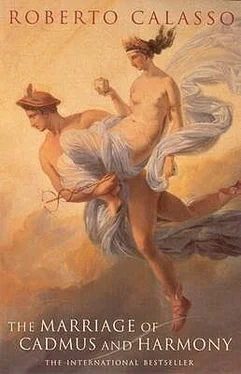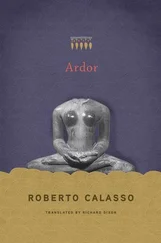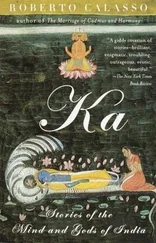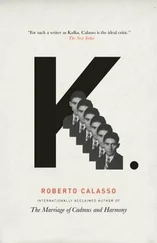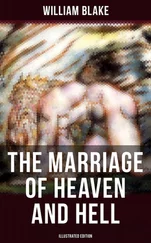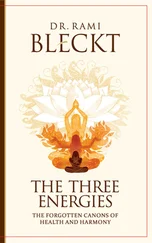Roberto Calasso - The Marriage of Cadmus and Harmony
Здесь есть возможность читать онлайн «Roberto Calasso - The Marriage of Cadmus and Harmony» весь текст электронной книги совершенно бесплатно (целиком полную версию без сокращений). В некоторых случаях можно слушать аудио, скачать через торрент в формате fb2 и присутствует краткое содержание. Год выпуска: 1993, Издательство: Alfred A. Knopf Inc, Жанр: Современная проза, на английском языке. Описание произведения, (предисловие) а так же отзывы посетителей доступны на портале библиотеки ЛибКат.
- Название:The Marriage of Cadmus and Harmony
- Автор:
- Издательство:Alfred A. Knopf Inc
- Жанр:
- Год:1993
- ISBN:нет данных
- Рейтинг книги:3 / 5. Голосов: 1
-
Избранное:Добавить в избранное
- Отзывы:
-
Ваша оценка:
- 60
- 1
- 2
- 3
- 4
- 5
The Marriage of Cadmus and Harmony: краткое содержание, описание и аннотация
Предлагаем к чтению аннотацию, описание, краткое содержание или предисловие (зависит от того, что написал сам автор книги «The Marriage of Cadmus and Harmony»). Если вы не нашли необходимую информацию о книге — напишите в комментариях, мы постараемся отыскать её.
The Marriage of Cadmus and Harmony — читать онлайн бесплатно полную книгу (весь текст) целиком
Ниже представлен текст книги, разбитый по страницам. Система сохранения места последней прочитанной страницы, позволяет с удобством читать онлайн бесплатно книгу «The Marriage of Cadmus and Harmony», без необходимости каждый раз заново искать на чём Вы остановились. Поставьте закладку, и сможете в любой момент перейти на страницу, на которой закончили чтение.
Интервал:
Закладка:
Diodorus Siculus: “They also say that the honors given to the gods and the sacrifices and rites of the mysteries originally came down to other men from Crete, and in making this claim they offer what they believe is an extremely strong argument. The initiation rite that the Athenians celebrate in Eleusis, the most illustrious, one might say, of all rites, and again the Samothracians’ rite and the rite begun by Orpheus in Thrace among the Cicones, all these rites are passed on from one initiate to another in secret. But in Cnossos, Crete, it has always been the custom to practice such initiation rites in broad daylight and to let everybody know about them. What is considered unnameable among other peoples is available for all who want to hear in Crete.”
Mystery, in Crete, was made plain to all, no one tried to hide it. The “unnameable things” that abounded in Attica were laid open to everybody. But there was no sense of challenge about this. Crete, with its hundred cities and not a single defensive wall around them, looked like a huge plaything. Only a tidal wave, or dark raiders striking from the sea, could have been its doom, not the recklessness of the sort of civilization that seeks self-knowledge, and in so doing destroys itself.
A few thousand years later, a famous morphologist of civilization was to be baffled by Crete, for, having studied the whole multitude of Cretan remains, he could find not a single indication of any historical, political, or even biographical consciousness, such as had always dominated Egyptian thought. For a man who hungered after the signs of great civilizations, Crete had something childish about it, something elusive, something below par.
The Linear B Tablets include many names of gods: about half were to go on living as Olympian gods, the other half were lost. We know nothing about them: they are mere names that appear alongside those of Zeus, Poseidon, Hera. As if the Olympian gods had once been far more numerous and now carried around with them the shadows of their lost brothers and sisters.
Crete: pots of grain numbered in the storehouses, seals showing beasts half one thing half another, delicate frescoes, ivory knots, lists of offerings, honey, inscribed poppy pods, ox skulls, double-edged axes. Columns of cypress wood, palaces with stairways and shafts of light, nameless tombstones. Tiny idols heaped in piles, not statues, not doubles made of stone. Nothing of the verticality of the divine, no sign of the hallucinatory presence of upright stone.
Stories never live alone: they are the branches of a family that we have to trace back, and forward. In the rapture of her sea crossing on the back of a white bull, Europa conceals within herself, like still undiscovered powers, the destinies of her love-crazed granddaughters Phaedra and Ariadne, who would one day hang themselves out of shame and desperation. And down among the celestial roots of this story tree we come across the wanderings of the mad heifer, the ancestral Io, who again holds within herself the image of another mad heifer, mother of Phaedra and Ariadne: Pasiphaë. And she too hanged herself in shame.
From a rock, Ariadne watches Phaedra on a swing. Lost in thought, she waits. Both are young princesses, in Cnossos. Daughters of Minos and Pasiphaë. They have lots of brothers and sisters. And a half brother too, Asterius. Asterius has a bull’s head, because his father was the big white bull Pasiphaë fell in love with. Asterius has been shut up in a building designed by an Athenian inventor who is on the run because, so rumor has it, he killed somebody. That covered building is strange indeed. The princesses were already familiar with the labyrinth, but in the past it had been out in the open for everybody to see, a broad space for the dance. They didn’t realize — nobody would have told them — that, when their father, Minos, set out to conquer the continent and the Cretans began to have too many dealings with the Greeks, the moment had come for them to cover up their secrets, and ultimately to be ashamed of them. Daedalus, the Athenian, designs a building in Crete that hides behind stone walls both mystery (the pattern of the dance) and shame (Asterius, the Minotaur). From that day on, the mystery is also the thing you are ashamed of.
This development depended, in turn, on the developing history of metamorphoses. Forms would become manifest insofar as they underwent metamorphosis. Each form had its own perfect sharpness, so long as it retained that form, but everybody knew that a moment later it might become something else. At the time of Europa and Io, the veil of epiphany was still operating. The bellowing bull, the crazed cow, would once again appear as god and girl. But as generation followed generation, metamorphosis became more difficult, and the fatal nature of reality, its irreversibility, all the more evident. Only a generation after Europa, Pasiphaë would have to crouch inside a wooden cow, a big toy on wheels, and have herself pushed as far as the meadows of Gortyn, where the bull she desired was grazing. And from their union was born a creature who would never be able to go back to being either beast or man. He would be a hybrid, forever. And just as the craftsman Daedalus had had to invent an inanimate object to allow the mother to love the bull, so now he had to invent another object, the labyrinth, to conceal the son. The Minotaur would be slain, Pasiphaë was to die in captivity and shame. Humans could no longer gain access to other forms and return from them. The veil of epiphany was rent and tattered now. If the power of metamorphosis was to be maintained, there was no alternative but to invent objects and generate monsters.
“Since it is the custom in Crete for the women to take part in the games, Ariadne was there with the others, and she was amazed when she saw Theseus, and admired his skill as, one after another, he overcame all adversaries.” While Ariadne gazes at the Stranger, Crete crumbles. Before being betrayed herself, Ariadne chose to betray her island.
Dionysus courts her, then accuses her, then kills her, then rediscovers her, then transforms her into the crown of the northern sky, Corona Borealis. But this is a different Dionysus from the one Ariadne knew in her childhood. He wasn’t even called Dionysus then. He was the Bull: the total Bull, who descends from the heavens like Zeus, rises from the sea like Poseidon, grazes under the plane trees of Gortyn. He encompassed all things: he was in the honey and blood offered to the gods, he was in the slender horns at each side of the altars, in the ox skulls painted along the walls of the palace. Youths with armbands, loincloths, and wavy hair gripped him by the horns at a run. The Bull had always followed Ariadne about, right from the start, always accompanied her, always kept his eye on her.
Now the Bull steps aside and the Athenian hero moves in. They would appear to be enemies, but they swap places very smoothly. The scene is already set. No more monster business now, but sordid affairs. That is Ariadne’s destiny. No more the childish, the regal palace, but the porticoes and public squares where tough, clever men take the first opportunity to stab each other in the back, where the word, which in Crete had served to take inventories of goods in warehouses, would become sovereign, vibrant, revered. Ariadne would not live to see all this: she stopped halfway, caught on another island, rocky and inhospitable. She closed her eyes, so as never to have to see again either the god or the man who of their natures could do nothing more than appear and disappear.
Theseus transformed the divine habit of carrying off young maidens into a human pastime. Every adventure he sets out on he carries off a woman, whether it be the Cretan Ariadne when he goes south or the Amazon Antiope when he heads north. There was always something playful and even reckless about these adventures. And some of them hardly finished in noble fashion, for no sooner had Theseus conquered a trophy than he was in a hurry to be rid of it, so as to go after another. At fifty he was still at it, carrying off a certain Helen who danced in the shrine of Artemis Orthia. On that occasion he was assisted by the only being to whom he would be faithful to the end: his friend Peirithous.
Читать дальшеИнтервал:
Закладка:
Похожие книги на «The Marriage of Cadmus and Harmony»
Представляем Вашему вниманию похожие книги на «The Marriage of Cadmus and Harmony» списком для выбора. Мы отобрали схожую по названию и смыслу литературу в надежде предоставить читателям больше вариантов отыскать новые, интересные, ещё непрочитанные произведения.
Обсуждение, отзывы о книге «The Marriage of Cadmus and Harmony» и просто собственные мнения читателей. Оставьте ваши комментарии, напишите, что Вы думаете о произведении, его смысле или главных героях. Укажите что конкретно понравилось, а что нет, и почему Вы так считаете.
